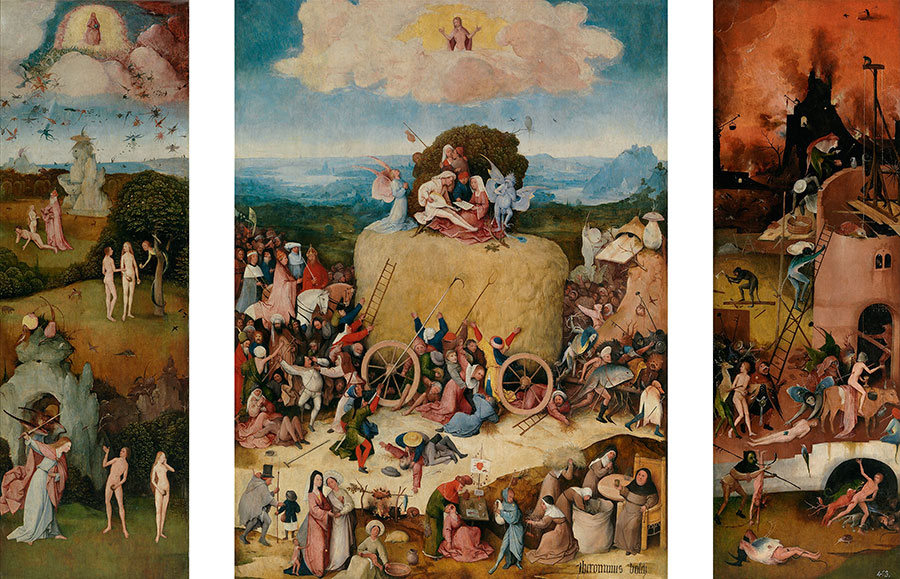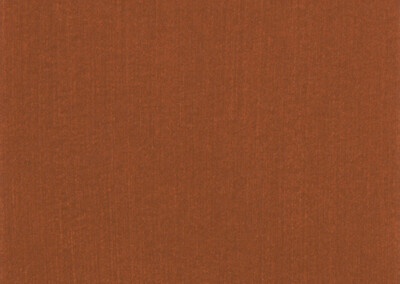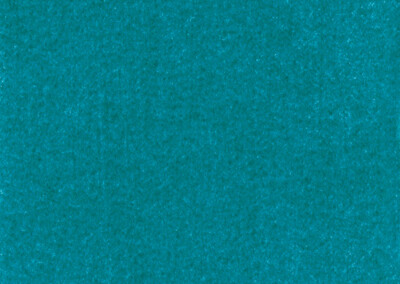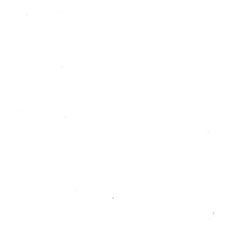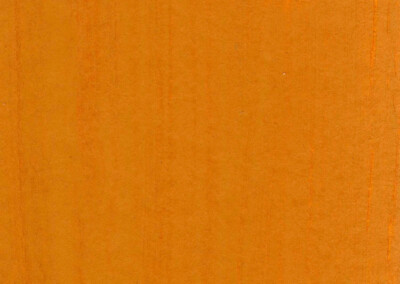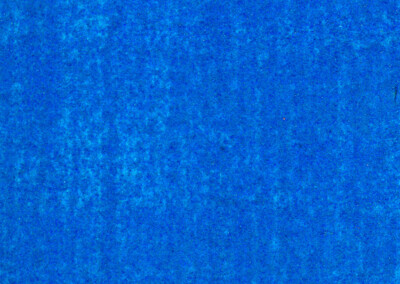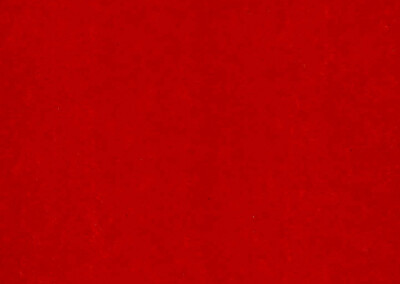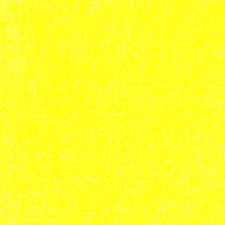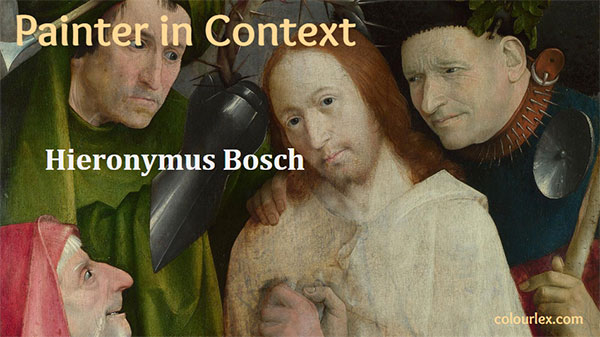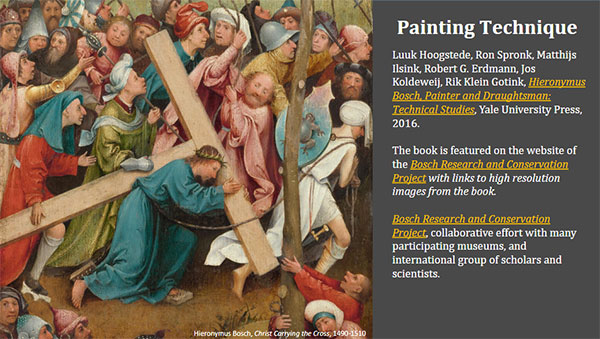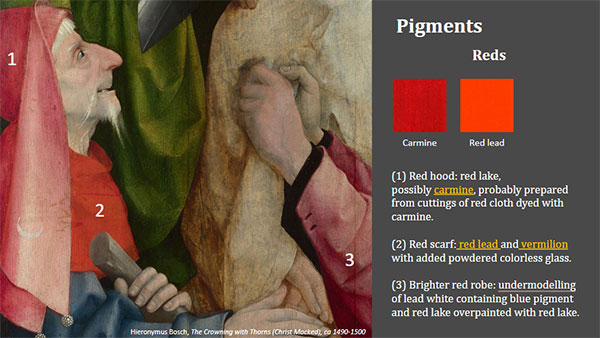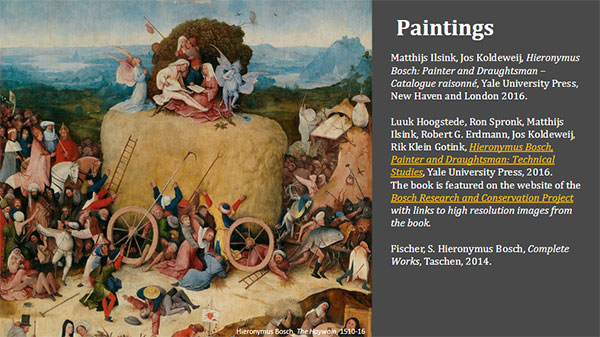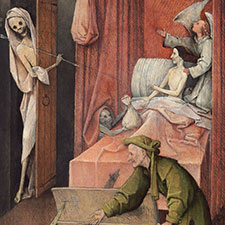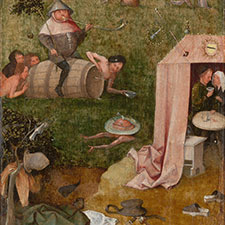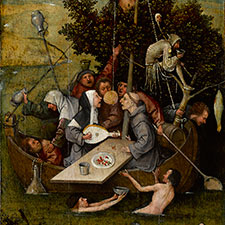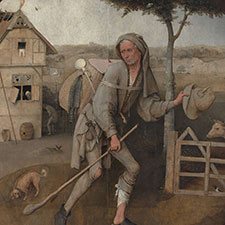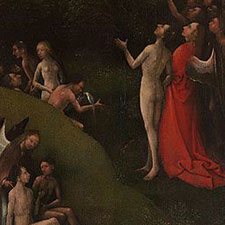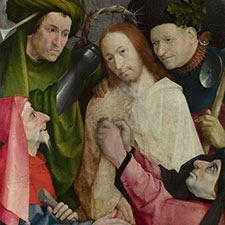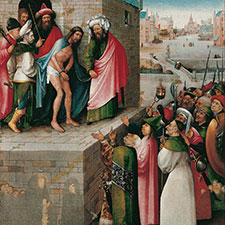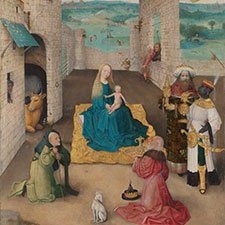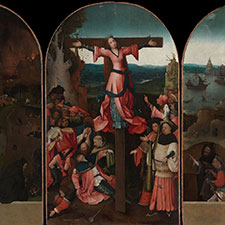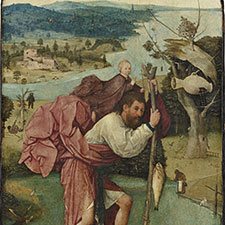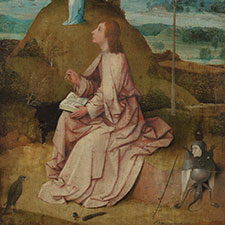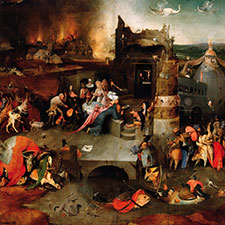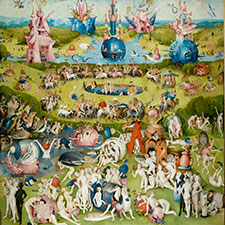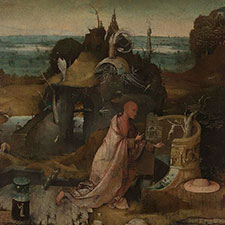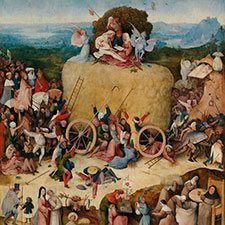Hieronymus Bosch, The Haywain Triptych
ca 1510-16Paintings sorted by Historical period | Painter | Subject matter | Pigments used
Overview
Hieronymus Bosch, The Haywain Triptych consists of four parts: the left panel named ‘Paradise’ shows the origin of sin on Earth with Adam and Eve being expulsed from Paradise by Archangel Michael. The center panel depicts mankind in sin trying to avail themselves of the earthly possessions symbolized by the hay. The right panel depicts the fires of Hell, while the back sides of both side panels show an old pilgrim trying to find his way in a dangerous world.
The triptych was thoroughly investigated by The Bosch Research and Conservation Project. The results of this investigation were published in a magnificent book referenced below. An extensive interactive online feature at the website of the project complements the book and shows all the images from the book in high resolution.
The pigment analysis reveals a limited palette consisting of the cheaper pigments employed in the Renaissance period, such as azurite, lead-tin yellow, vermilion, carmine kermes, and ochres.
Medium: Oil and tempera
Support: Oak
Size: Height including frame: 147.1 cm
width including frame: 224.3 cm
Art period: RenaissanceMuseo Prado Madrid
Inventory number: P02052
Painting at the website of the BOSCH PROJECT
Parts of the Triptych
Left Panel: ‘Paradise’

Central Panel: ‘The Haywain’
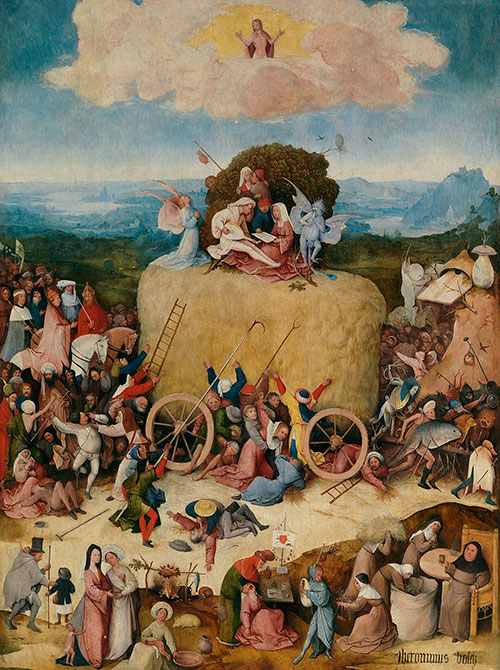
Right Panel: ‘Hell’

Closed Side Panels: ‘The Wayfarer’
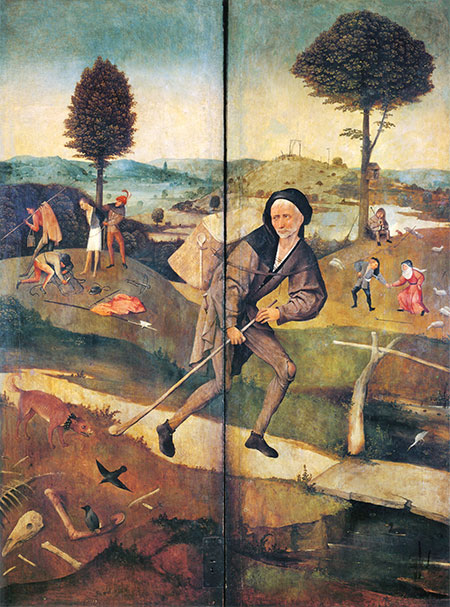
Pigments
Pigment Analysis
This pigment analysis is based on the work of the scientists at The Bosch Research and Conservation Project (1). The scientists employed X-ray radiography (XRR), infrared photography (IRP),https://yalebooks.yale.edu/book/9780300220155/hieronymus-bosch-painter-and-draughtsman/ and infrared reflectography (IRR) to gain insights into the inner layers of the painting and to identify the pigments.
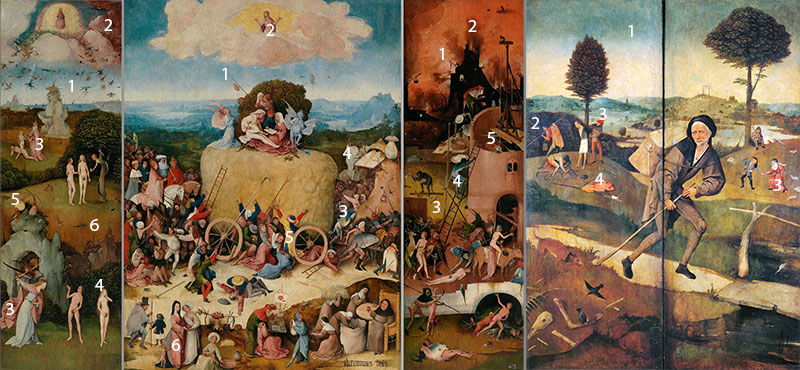
Left Panel: ‘Paradise’
1 Blue sky: azurite and lead white in varying proportions.
2 Red parts of the sky: opaque vermilion.

3 Archangel Michael’s red robe at lower left and God’s drapery in the upper part: carmine kermes lake probably prepared from dyed red textile cuttings.
4 Eve’s hair: warm brown base overpainted with yellow ochre and lead-tin yellow.
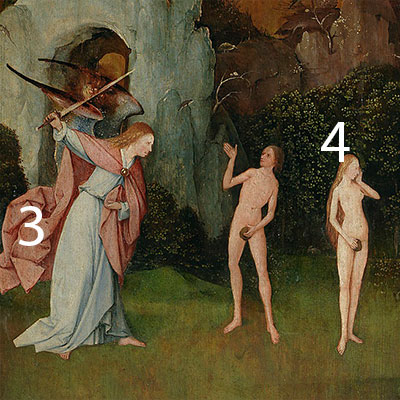
5 Yellow fruit: lead-tin yellow with highlights in lead white. Top and bottom: carmine kermes lake mixed with lead white.
6 Brownish ground: vermilion mixed with other pigments.
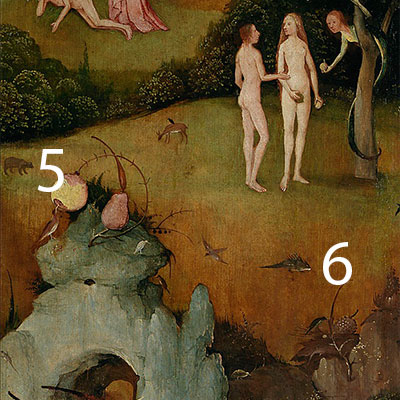
Center Panel: ‘The Haywain’
1 Blue sky: azurite and lead white in varying proportions.
2 Christ’s body: lead white, carmine lake, lead-tin yellow, vermilion and brown ochre.
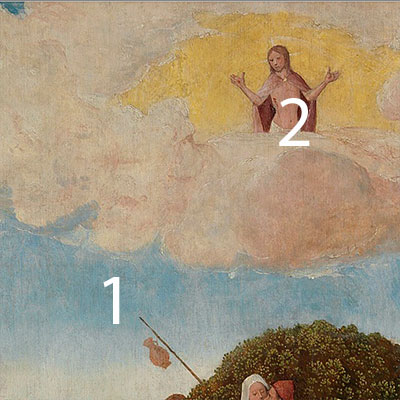
3 Figure with the branches: black, lead white, lead-tin yellow, brown ochre, azurite, red lake and greenish and pinkish colored paints.
4 Rocky feature: grey paint containing azurite, lead white, red lake and smaller quantities of black and brown. Highlights are painted in lead-tin yellow.
5 Yellow robe of the figure in the center: lead-tin yellow with detailing in red lake mixed with lead white.
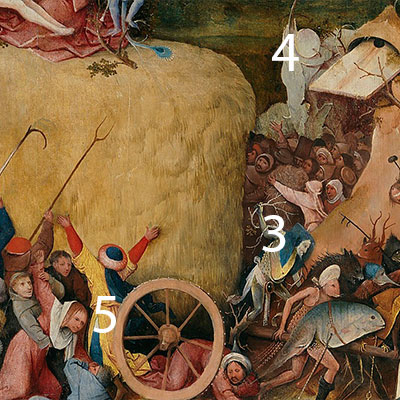
6 Red robe of the woman at the bottom left: lead white underpainting covered with red lake.

Right Panel: ‘Hell’
1 Fires in the background: vermilion and red lake with highlights in lead-tin yellow and lead white.
2 Smoke in the background: red-brown paint with green glaze and azurite.
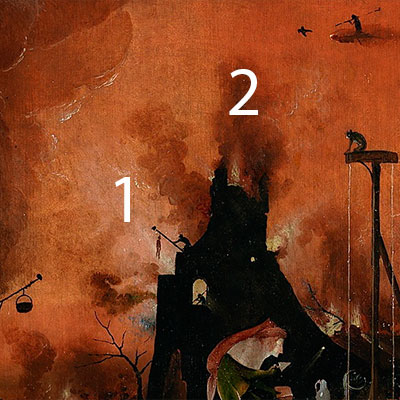
3 Yellow ground: yellow ochre.
4 Blue demon climbing the ladder: azurite, red lake, and lead white. The hairs, neck, and eyes were painted in red lake, the shoulder was done in brownish paint.
5 Animal on the round tower: the red carapace was painted in red lake. The dots are executed in lead-tin-yellow and claws in lead white and azurite. The bill is painted in lead-tin yellow.
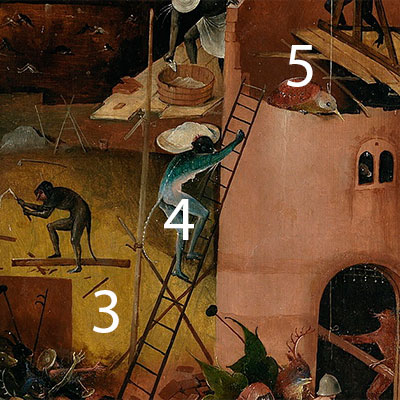
Closed Side Panels: ‘The Wayfarer’
1 Blue sky: azurite and lead white in varying proportions.
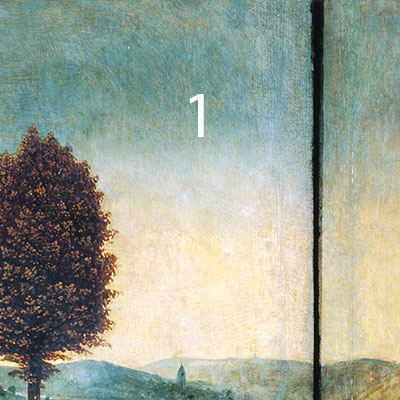
2 Green shrubbery: .brownish base overpainted with a green glaze consisting probably of verdigris.
3 Red hat: vermilion with a red lake in the shadows.
4 Red robe on the ground: pink base with lead white highlights and pure red lake for the lines and shadows.
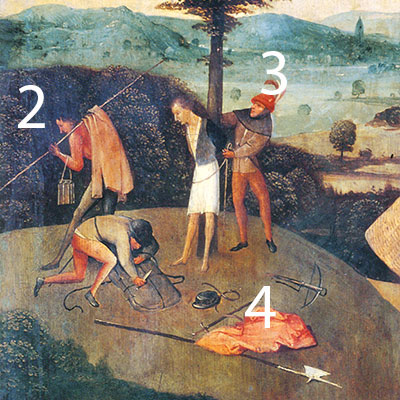
References
(1) Luuk Hoogstede, Ron Spronk, Matthijs Ilsink, Robert G. Erdmann, Jos Koldeweij, Rik Klein Gotink, Hieronymus Bosch, Painter and Draughtsman: Technical Studies, Yale University Press, 2016, pp. 296 – 313.
(2) Carmen Garrido and Roger Van Schoute, Bosch At The Museo Del Prado – technical Study, Aldeasa Publishers 2001.
Pigments Used in This Painting
Resources
See the collection of online and offline resources such as books, articles, videos, and websites on Hieronymus Bosch in the section ‘Resources on Painters‘
PowerPoint Presentations
Painter in Context: Hieronymus Bosch
A richly illustrated presentation on the painting technique and pigments employed by Hieronymus Bosch specially crafted for Art Education. (Number of Slides = 20)
- Each presentation starts with the basic resources on the painter such as his biography, main catalogs of his paintings, and a bibliography.
- Next, you find slides describing the painting technique of the artist and the pigments he usually employed in his work.
- The majority of the slides show examples of paintings containing the specific pigments.
Slides showing the basic resources on the life and works of the Northern Renaissance painter Hieronymus Bosch.
The painting technique and all pigments employed by Bosch are shown in the next slides.
The majority of the slides show important examples of paintings where Bosch employed specific pigments. The slides are organized according to the color of the pigments.
Videos
Video: 'Technical study: Hieronymus Bosch, The Haywain Triptych' by Museo del Prado
Pilar Silva, Head of the Department of Spanish Painting (1100-1500) and Flemish Painting and Northern Schools (1400-1600), and Jaime García-Maiquez, Technical Documentation Department, comment The Haywain Triptych (1512 – 1515) by Bosch. 16 June 2016. Museo del Prado.
Video: 'Commented Works: Hieronymus Bosch, The Haywain Triptych' by Museo del Prado
Alejandro Vergara, Chief Curator of Flemish and Northern School Paintings at the Museo Nacional del Prado, comments on the work “The Haywain” by Bosch. Museo del Prado.
Publications and Websites
Publications
(1) Matthijs Ilsink, Jos Koldeweij, Hieronymus Bosch: Painter and Draughtsman – Catalogue raisonné, Yale University Press, New Haven and London; 2016. pp 336-355.
This book is also available online in pdf format in two parts: part I and part II.
(2) Luuk Hoogstede, Ron Spronk, Matthijs Ilsink, Robert G. Erdmann, Jos Koldeweij, Rik Klein Gotink, Hieronymus Bosch, Painter and Draughtsman: Technical Studies, Yale University Press, 2016, pp. 296 – 313.
(3) Einem, H.Von, Zur Deutung des Heuwagentriptychons Von Hieronymus Bosch, Vandenhoeck and Ruprecht, Gottingen, 1975, pp. 3-20.
(4) Carmen Garrido and Roger Van Schoute, Bosch At The Museo Del Prado – technical Study, Aldeasa Publishers 2001.
(5) Daniel Mc Dermon, Art Gone to Hell: A Boschian Bestiary, The New York Times online, March 4, 2016.
(6) Jörg Traeger, Der “Heuwagen” des Hieronymus Bosch und der eschatologische Adventus des Papstes, Zeitschrift für Kunstgeschichte 33. Bd., H. 4 (1970), pp. 298-331.
Websites
Website of the Bosch Project
Website of the Bosch Research and Conservation Project

